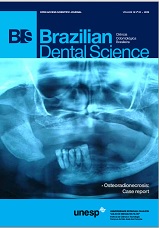Influence of different fermentable carbohydrates on dual-species biofilms of S. mutans and A. naeslundii – a pilot study
DOI:
https://doi.org/10.14295/bds.2015.v18i2.1100Abstract
Objective: The aim of this study was to elucidate the effect of presence of different fermentable carbohydrates in the biomass and acidogenicity of biofilm formed by Streptococcus mutans ATCC 25175 in association with Actinomyces naeslundii ATCC 19039. Material and Methods: Single-specie and dual-species biofilms were grown at the bottom of microtiter plates at equal concentration for 24 h at 37 ºC. Carbohydrates were added at 2%: maltose, sucrose, glucose and lactose and as negative control, BHI Broth (0.2% glucose) was used. The pH of each culture was measured to assess acidogenicity after 24 h, immediately after refreshing the culture medium and for the next 30 min, 1 h and 2 h. Crystal violet assay was used as indicator of the total attached biofilm biomass after 24 h incubation and the absorbance was measured at 590 nm. Tukey Multiple Comparison Test was performed for all the statistical analyses. Results: In general, higher amount of biomass was formed by dual-species than single-specie biofilm in the presence of all carbohydrates, except to glucose. In relation to pH, statistically significant differences were observed in S. mutans biofilm only after 24 h, when all carbohydrates showed higher acidogenicity than control group, whereas in dual-species biofilm the highest acidogenicity were found after 24 h for sucrose, lactose, maltose and the control group. Conclusion: The findings indicate that the type of biofilm (single or dual-species) and the carbohydrate used may influence both amount of biomass formed and rate of the pH fall.
Downloads
Downloads
Additional Files
Published
How to Cite
Issue
Section
License
Brazilian Dental Science uses the Creative Commons (CC-BY 4.0) license, thus preserving the integrity of articles in an open access environment. The journal allows the author to retain publishing rights without restrictions.
=================




























